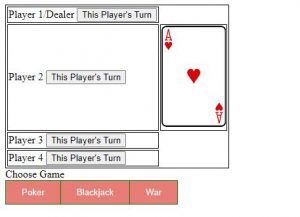I was able to accomplish both of my desired goals this week. The first goal was writing the necessary code to visualize the card games War and Blackjack. This required writing some backend Python game logic and some JavaScript/HTML to convey the hands of each player. Blackjack does require user input to click on which player’s turn it is (as it isn’t predetermined how many cards a player will want to draw before stopping). This can be seen in the below picture, where there are buttons saying “This Player’s Turn”. Users can specify when they are done drawing cards by clicking on the appropriate button to indicate whose turn it is.

In addition, I wrote Python code to communicate with the web app via POST requests (this code will be stored on the Jetson Nano), and I wrote Python code to train and test a SVM model with an RBF kernel. This choice of model and hyperparameter should achieve our desired accuracy given online research. As our first iteration of preprocessed data becomes available in the coming days, I will input this data as training/validation data and analyze the model’s performance. In addition, I will start the process of writing code to train and test a fully connected neural network through PyTorch. These are my main goals in the coming week. If I have time, I will also try to make the web app’s UI more intuitive to create a better and more complete user experience (highlight which player’s turn it is, allow user to specify players’ names, add button to indicate when game is over, styling, etc). In addition, based on conversations with Professor Fedder last week, our web application could utilize some sort of security/authentication to ensure only verified users can submit requests on the website. This would preserve the integrity of information on the web app, and so this is another action item to possibly be completed. I’m adding these two tasks to my schedule, and so below is an updated look at my schedule. These action items for the web app do not bear much significance to the rest of the team, so the overall team schedule will not change as a result of these updates.

I am currently on schedule, but these next few weeks will be very tough. I recently contracted COVID and am experiencing mental/physical symptoms. Hence, my ability to focus and do work has deteriorated. I have been in contact with Professor Fedder, Ryan, and the rest of my team to ensure they are aware of my current health status. As of now, I still plan on completing all my work on schedule.


